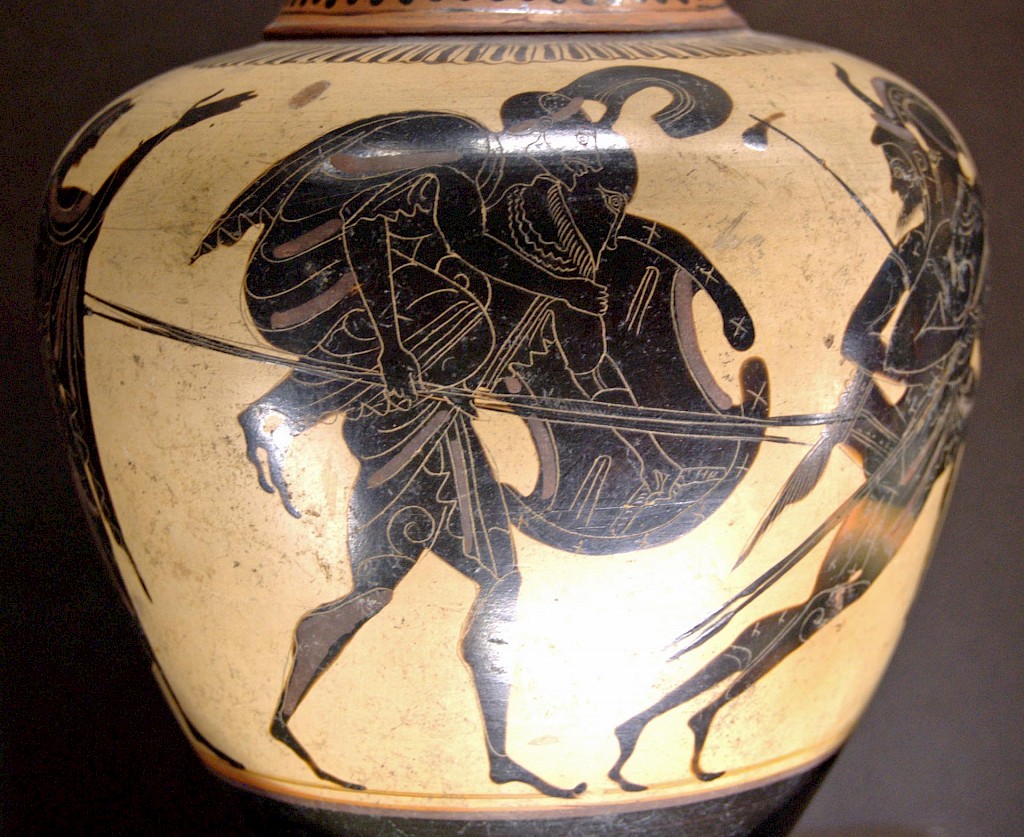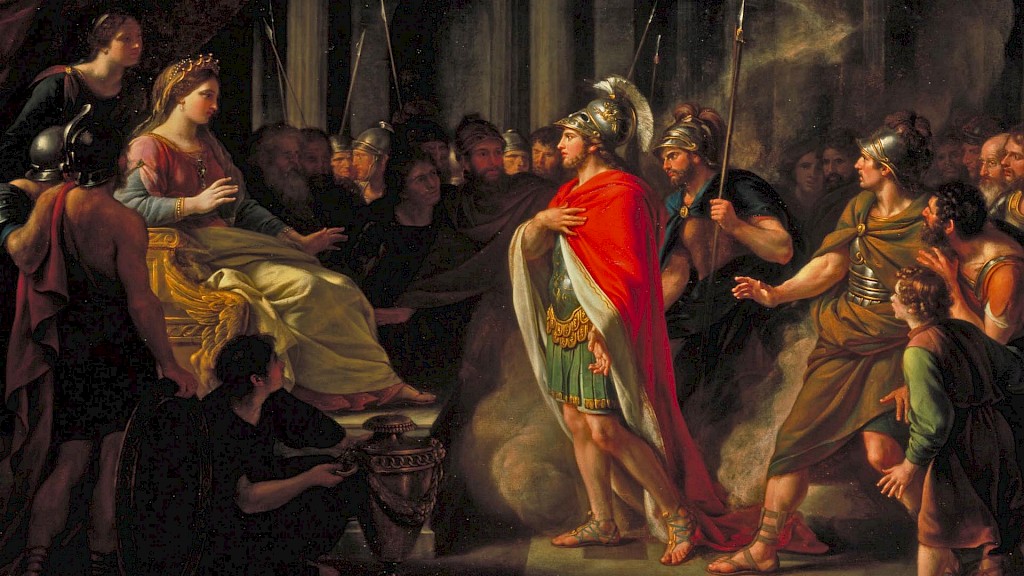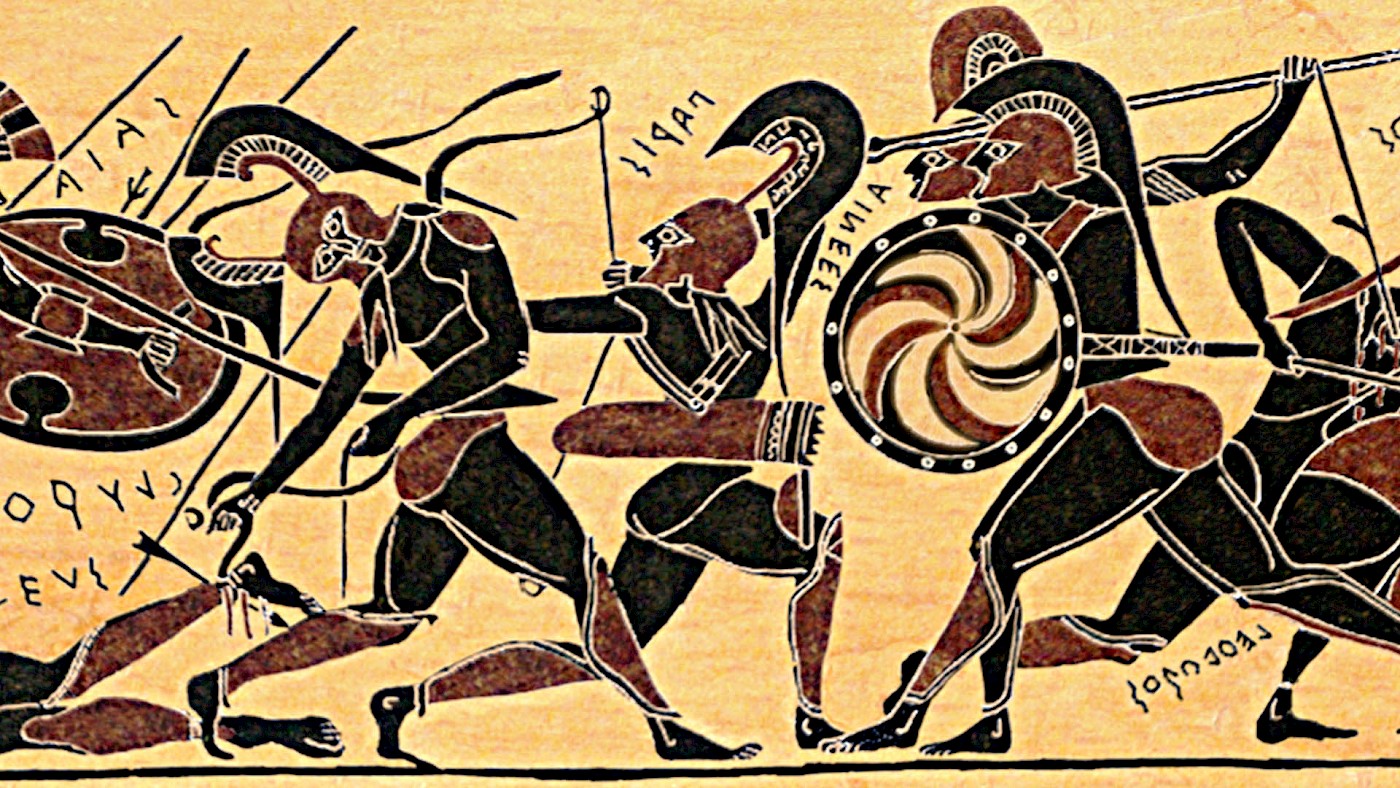When the Roman poet Virgil (70 BC–19 BC) composed his epic poem about Aeneas, he did not come up with the entire story himself. Certainly, some elements were his own invention. The part where Aeneas descends into the underworld and is shown a vision of his descendants’ future greatness, is a clear example of Virgil adapting the story to celebrate the achievements of Rome’s first emperor, Augustus. Likewise, the conflict between Dido and Aeneas was used to explain why the later Carthaginians and Romans were at odds with each other.
The hand of the author is also clearly visible in the overall structure of the work. The poem itself is consciously modelled after the two Homeric epics that preceded it. The first six books of the Aeneid are clearly inspired by the Odyssey, as they detail Aeneas’ wanderings through the Mediterranean. The latter six books deal with Aeneas’ struggles in Italy, his confrontation with Turnus, and are clearly modelled after the Iliad.
Fated to survive
Large parts of Aeneas’ story had been current well before Virgil had even been born. In the twentieth book of the Iliad, which was probably composed around 700 BC, Aeneas is saved by Poseidon from being slain by Achilles. His reasoning for doing so? Aeneas was a descendant of Dardanos, Zeus’ favourite son, and the supreme deity did not want the line of Dardanos to be snuffed out completely; only the branch that Priam belonged to was fated for extinction.

The poem Iliou Persis (i.e. “Sack of Troy”) gives some further details. Like the Iliad and the Odyssey, it’s part of the so-called “Epic Cycle”, the poems that together told the story of the Trojan War. (Some also include a poem about the gods, the Titanomachy, and the poems of the Theban Cycle; all of them have been lost, save a few fragments.) Like all other poems from that Cycle, apart from the Homeric ones, the Iliou Persis has not survived. A summary of the story was written down by Proclus in the fifth century AD. The poem itself was considered a work of Arctinus of Miletus, who might have been active as early as the eighth or seventh century BC.
When the Trojans had discovered the Wooden Horse on the beach and deemed that the Greeks had fled, the priest Laocoon warned that it was a trap, and for this he was killed by giant serpents sent by the gods. The Trojans then took the Wooden Horse inside the city and the rest, as they say, was history. According to Proclus’ summary of the Iliou Persis, Aeneas had misgivings and abandoned the city after Laocoon’s death, taking part of the population with him. Most other (later) sources suggest that Aeneas didn’t leave the city until the Greeks had actually started sacking and burning it.

Interestingly, a fragment of another poem from the Epic Cycle, known as the Little Iliad, claims that Aeneas had actually been taken prisoner by Neoptolemus, the son of Achilles. But this appears to have been an outlier: most Greek sources suggest that Aeneas either escaped the destruction of Troy or was even allowed to leave after negotiating a truce with the Greeks.
From the second half of the sixth century, there are a considerable amount of Attic black-figure vases that depict Aeneas carrying his father Anchises to safety. Sometimes a child is also present; one assumes it must be Ascanius. A woman is often present, leading the way; perhaps she is to be identified as Creusa, Aeneas’ wife. Creusa was also a daughter of Priam and Hecuba (and therefore destined to die at Troy). It should be noted that most of these black-figure vases were found in Etruria and were perhaps deliberatedly made for the Etruscan market, for example if the Etruscans already considered Aeneas a founder hero.
Settling on the Italian peninsula
Hellanicus of Mytilene (fifth century BC) was a logographer who wrote a number of works that have survived in fragmentary form. He was one of a few Classical authors who wrote about Greeks and Trojans who had moved to the west and settled in Italy and Sicily (see also Thucydides 6.2.3).
Hellanicus’ Troïka says that Aeneas defended Troy. When it was clear that all had been lost, he led a group of Trojans to Mount Ida. When the Greeks then decide to assault the mountain, a truce is reached, with the Greeks allowing the remaining Trojans to leave and search for a new place to live.
Most of the Trojans sail to Pallene in Chalcidike (in the northern Aegean). Closeby, in Thrace, Aeneas was said to have founded a city named after him: Aenea (i.e. Aineia). A cult dedicated to the hero existed here and his likeness was depicted on coins in the fifth and fourth centuries BC (see also Livy 3.1.8). Some later writers claim that Aeneas died here or, confusingly, moved to Arcadia, in the very heart of the Peloponnese. Dionysius of Halicarnassus instead argues that Aeneas continued westward. Certainly, stories abound of heroes, including Odysseus and Heracles, who founded numerous cities during their wanderings.

In Dionysius’ summary of the poem Priestess of Hera at Argos, also attributed to Hellanicus, we meet some more familiar elements. The Trojan women were ostensibly tired of wandering and set fire to the ships; an element repeated in the Aeneid and also known from other stories regarding the Nostoi (or “Returns”) of famous heroes. Aeneas then decided to settle where they were and named the city he founded after one of the Trojan women, who was called Rhome (Dion. Hal. 1.72.2 = FGrH 4 F 84). Hellanicus has Aeneas travel to Italy accompanied by Odysseus, a Greek-Trojan pairing that Ian Malkin (see bibliography) has stressed wasn’t uncommon.
In any event, this is quite a different tale from the more familiar, and presumably later tradition in which Romulus, one of Aeneas’ descendants, founded the city and named it after himself. But countless stories developed among the Greeks, as no doubt also among the native populations in Italy, regarding the origins of the city of Rome and its inhabitants.
Some sources claimed that Rhome married Latinus and that their children were Romulus and Remus, while others suggested that Aeneas himself had been the father of Rome’s most famous twins. Regardless, most early sources suggest that only a few generations separated Aeneas from the founding of Rome: the large gap found in the Aeneid was probably introduced by Virgil.
Journeys to the west
When Virgil composed his Aeneid he was working with material that had been circulating for centuries. The stories around Aeneas’ escape from Troy and his journey west should be seen within the context of similar Greek tales about travelling heroes. After all, Odysseus’ wanderings took him west. The labours that Heracles had to perform beyond the confines of the Aegean generally took him further west. Of the other Greek heroes who fought at Troy, Diomedes, the king of Argos, eventually went west and settled in Italy, specifically in Daunia (Apulia).
These stories all developed in a time when Greeks actively ventured west to settle new lands. Between ca. 800 and 500 BC, many Greeks abandoned their home country to settle elsewhere. Italy and Sicily were among their most popular destinations. So many Greeks eventually settled in Southern Italy and Sicily that the Romans referred to the region as a whole as Magna Graecia, or “Great Greece”.
The Trojans were broadly similar to the Greeks as far as culture and religion were concerned, but at the same time also different. Little was known about the supposed historical Trojans: myth and legend had conveniently wiped out their existence in Anatolia. As such, a Trojan hero was a handy vessel for native populations to adopt as their founder hero: they didn’t have to proclaim themselves as descendants of Greeks (though some, of course, did), while at the same time they didn’t have to completely turn away from Greek culture either.
It’s perhaps no surprise that the Romans embraced Aeneas as their ancestor. Aeneas was pious and brave, with sources placing him well back into the age of hallowed antiquity. He had been celebrated by Greeks and Trojans alike. He was a demigod himself (son of Venus/Aphrodite) and had enjoyed the protection of the gods, and he had ultimately led his people to safety in Latium. Aeneas was a worthy hero.
Further reading
- J. Boardman, The Archaeology of Nostalgia: How the Greeks Re-Created Their Mythical Past (2002).
- J.S. Burgess, The Tradition of the Trojan War in Homer and the Epic Cycle (2001).
- T.H. Carpenter, Art and Myth in Ancient Greece (1991).
- T. Gantz, Early Greek Myth: A Guide to Literary and Artistic Sources (two volumes; 1993).
- I. Malkin, The Returns of Odysseus: Colonization and Ethnicity (1998).
